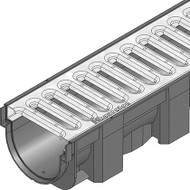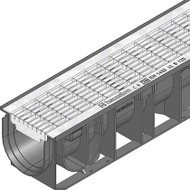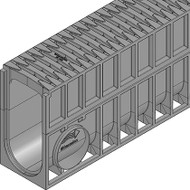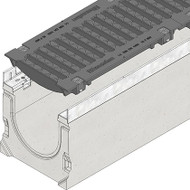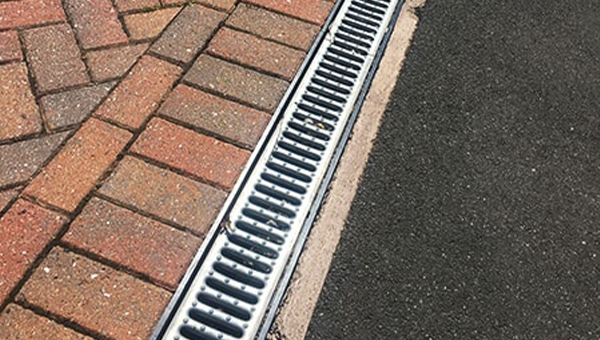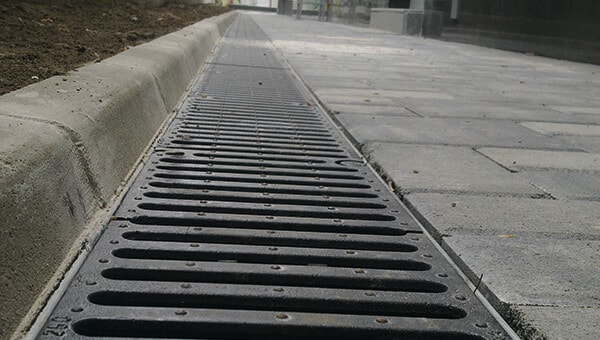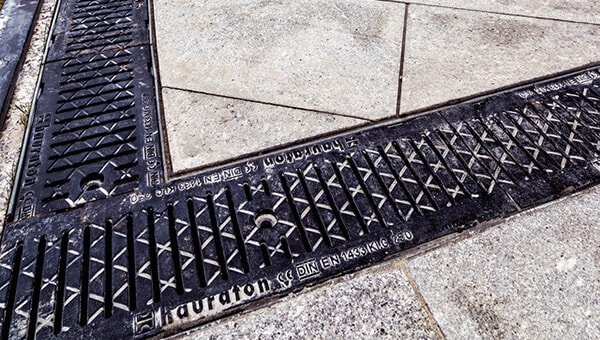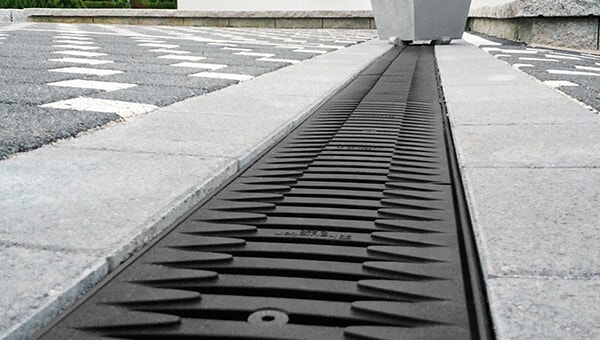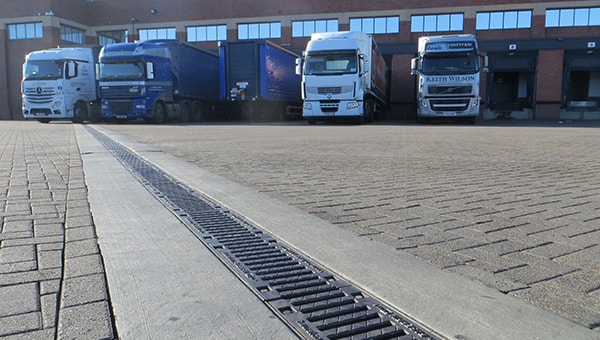Whether you're new to the concept of channel drainage or an expert seeking more information, this FAQ aims to address the most common questions we get asked in short, concise answers.
Channel Drainage: Frequently Asked Questions
Want to know how channel drains work but don’t have time to read a long-form article? Need quick answers to your installation and maintenance questions? This FAQ article has all the channel drain information you need in bite-sized chunks.
General Channel Drainage FAQs
Commonly asked questions about channel drainage. For more detailed information, check out our Basic Guide to Channel Drainage.
What is channel drainage?
Channel drainage, also known as linear channel drainage, drainage channels, and trench drainage, refers to a system of recessed gutters installed in the ground that are designed to efficiently manage surface water runoff by collecting and channelling it away from areas prone to flooding or water accumulation. A typical system consists of a series of linear channels with grated or slotted covers that capture water and direct it to a designated outlet.
How do channel drains work?
Channel drains operate on the principle of gravity. The channels are typically installed at a slight downward slope, allowing water to flow into the channel and move towards the outlet. The grated or slotted covers prevent debris and larger particles from entering the drainage system, ensuring smooth water flow.
Where can channel drainage be used?
Linear channel drainage is commonly used in various settings, including residential, commercial, industrial, and public areas. It's particularly effective in locations with poor natural drainage, such as driveways, patios, walkways, parking lots, pool areas, and sports facilities.
Why are channel drains important?
Channel drains play a crucial role in preventing waterlogging, flooding, and erosion in areas with heavy rainfall or poor drainage systems. By effectively collecting and channelling water away from structures and paved surfaces, they safeguard against property damage, maintain pavement integrity, and enhance safety for pedestrians and vehicles.
What are the advantages of using channel drains?
Linear channel drainage offers several benefits, including efficient water removal, prevention of surface water accumulation, reduced erosion, improved safety by minimising slip hazards, and protection of infrastructure from water damage.
How do channel drains prevent water accumulation?
Linear channel drainage prevents water accumulation by swiftly collecting surface water and directing it away from the area. This helps prevent flooding, soil erosion, and potential damage to property or landscaping.
What factors should I consider when selecting a channel drainage system?
Consider factors such as the drainage capacity needed, the load-bearing requirements (pedestrian, vehicle, or heavy-duty), the material of the system, aesthetic preferences, and compatibility with your landscape. A more detailed list of considerations can be found in our “7 things to consider when buying channel drainage” article.
How do I determine the appropriate channel drain size and capacity?
Technically, the size and capacity of the channel drainage you need will depend on the size of your application and the anticipated water volume in the area. There is a complicated series of formulas you can use to work this out, but for most domestic projects (with surface areas under 250m2), any channel drain rated appropriate for the required loading class should have sufficient run-off capacity. If your surface area is over 250m2 or is on a steep slope, we’d recommend consulting with a professional for guidance.
What type of channel drain should I use for my driveway?
The type of channel drain that you need for your driveway will depend on the size and slope of your driveway, the amount of traffic it receives, and the type of paving material.
- For smaller driveways with light traffic (cars and bikes), a plastic channel drain with a B125 grate may be sufficient.
- For larger driveways with heavier traffic (vans & lorries), a concrete channel drain with a C230 grate may be necessary.
- If your driveway has a steep slope, consult with a professional to ensure you select a system that can handle the higher volume run-off.
What materials are channel drainage systems typically made from?
Linear channel drainage systems are often made from materials like polymer concrete, plastic, stainless steel, or galvanized steel. These materials offer durability, resistance to corrosion, and the ability to handle varying loads.For more information about channel drain materials, check out our “Channel drain materials and gratings explained” article.
What is the best material for channel drains?
The best material for channel drains will depend on the specific application. Some common materials include concrete, plastic, and stainless steel. Concrete drains are durable and can withstand heavy loads, but they can be heavy and difficult to install. Plastic drains are lightweight and easy to install but may not be as durable as concrete drains. Stainless steel drains are the most durable and corrosion-resistant, but they are also the most expensive.
Can linear channel drainage be customised to match my landscape?
Yes, many linear channel drainage systems offer design flexibility. You can choose from various grate styles, colours, and materials to ensure the system blends seamlessly with your landscape design.
What channel drain design options are available to blend with different surroundings?
Grate patterns range from simple slotted designs to more intricate architectural patterns. Some systems even allow you to insert decorative elements like stones or tiles into the grates for a personalised look. Such bespoke options, however, come at a greatly increased cost and will only be available from specialist suppliers.
What are some common residential and commercial channel drain uses?
In residential settings, linear channel drainage helps manage water around homes, prevents flooding, and enhances landscaping. In commercial spaces, it aids in maintaining safe walking and driving surfaces and protecting infrastructure.
Channel Drain Installation FAQs
Commonly asked questions about how to install a channel drain system. More detailed information can be found in our channel drain installation guide.
Can I install linear channel drainage myself?
Yes, installing channel drainage is one of the more DIY-friendly projects for domestic applications. However, unless you are comfortable working with drainage systems, it's often recommended to consult a professional to ensure proper slope, alignment, and overall effectiveness. Our “How to plan and prepare for a channel drain installation” article has more information about what you'll need to consider.
What's involved in a channel drain installation process?
The installation process includes excavating a trench, placing the channel system, ensuring proper slope, connecting the system to an outlet or drainage pipe, and securing the grated or slotted cover. Proper compaction and backfilling are crucial for stability. More detailed information can be found in our channel drain installation guide.
What are the considerations for effective channel drain water flow?
Proper grading and alignment are essential. The slope of the channel should be sufficient to allow water to flow freely but not so steep that it overloads the drainage outlet.
When should I consult a professional for linear channel drainage installation?
It's advisable to consult a professional if you're unsure about the appropriate slope, load-bearing requirements, or the installation process. Professionals ensure the system is installed correctly for optimal performance.
How do I find a reliable contractor with experience in channel drain installations?
Seek recommendations from friends, family, or neighbours who have had similar work done. Research online reviews and ask for references from potential contractors. Verify their expertise and experience in linear channel drainage installations. Websites such as Checkatrade.com are a good place to start.
Channel Drain Maintenance and Cleaning FAQs
Commonly asked questions about how to clean and maintain a channel drain system. More detailed information can be found in our channel drain maintenance guide.
How do I maintain a channel drain system?
Regular channel drain maintenance involves removing debris from the grate or slots to prevent clogs, ensuring that the channel is clear of obstructions, and inspecting the system for any signs of damage. Professional cleaning and maintenance might also be recommended annually.
How often should I clean my channel drainage system?
Inspect your drains at least once a month and clear any debris from the grates or channels as needed to maintain optimal performance. Regular cleaning is recommended, especially after heavy rains or periods of high debris accumulation.
What are the best practices for channel drain maintenance?
Use gloves and appropriate tools to remove debris. Avoid using chemicals that could damage the system or harm the environment. Regular inspection helps identify potential issues early.
How do I repair a damaged channel drain?
If your channel drain is damaged, you can try to repair it yourself, or you can call a professional to do it for you. If the damage is minor, you may be able to fix it with a concrete patch or epoxy. If the damage is more extensive, you may need to replace the entire drain.
How can I prevent debris from clogging the channel drainage system?
Using a leaf blower or broom to keep the surrounding area clean can help reduce the likelihood of debris entering the drainage system. Additionally, consider installing a leaf guard or catch basin to trap larger debris.
Are there any recommended channel drain accessories to enhance clog prevention?
Some linear channel drainage systems offer removable baskets or catch basins that collect debris before it enters the main channel. These can be periodically emptied to prevent clogs.
What steps can I take to ensure optimal water flow within the channel drains?
Regularly inspect the channel for any obstructions. Ensure the outlet is clear and unobstructed and that the system's slope hasn't been compromised by settling or erosion.
Are there any warning signs of poor channel drainage performance?
Signs include standing water around the drain, slow water flow, and water backing up during heavy rains. These can indicate a clog or improper slope.
What should I do if my channel drainage system isn't functioning as expected?
If you notice poor water flow or other issues, start by checking for debris clogs. If the issue persists, consult a professional to assess the slope, alignment, and overall system performance.
Other Channel Drain FAQs
Commonly asked questions about other aspects of channel drainage systems.
What distinguishes linear channel drainage from traditional point drains?
Linear channel drainage covers a broader surface area, collecting water more efficiently. Traditional point drains, such as gully pots, are limited to specific points and may struggle with larger water volumes.
How does channel drain compare to permeable paving in terms of effectiveness?
While both systems manage water, linear channel drainage focuses on quickly channelling water away, while permeable paving allows water to infiltrate the ground gradually. The choice depends on your specific needs and preferences.
Is linear channel drainage environmentally friendly?
Linear channel drainage can be environmentally friendly when designed to prevent soil erosion and localised flooding. It helps direct water to proper outlets, reducing erosion and protecting water quality.
How do drainage channels contribute to water conservation and sustainable landscaping?
By efficiently managing water runoff, linear channel drainage can help minimise wastage and support sustainable landscaping practices. It directs water to plants and vegetation, enhancing landscape health.
Are there any regulations or permits required for installing linear channel drainage?
Regulations vary by location. Some areas require permits for major landscaping modifications that affect water flow. Check with your local authorities to ensure compliance with regulations.
How can I ensure my channel drain complies with local building standards?
Consult with a professional familiar with local building standards and drainage regulations. They can guide you through the process and ensure your installation adheres to all necessary requirements.
What factors influence the cost of a linear channel drainage system?
Factors include the length and width of the drainage area, the chosen materials, the complexity of the installation, and any additional features, such as decorative grates.
Are channel drains a cost-effective solution in the long run?
While there might be an upfront investment, linear channel drainage can save you money in the long run by preventing costly water damage to property and infrastructure.
In conclusion, linear channel drainage is a versatile and efficient solution for managing surface water in various environments. By addressing a wide range of questions in this FAQ guide, we hope to have provided valuable insights for both beginners and experts in the field.
If you're considering implementing a linear channel drainage system, remember to factor in installation, maintenance, design, and compatibility with your specific application. Our comprehensive series of channel drain articles cover everything you need to know in a lot more detail. If you are looking to buy a system, we have a wide range of high-quality Channel Drain products available online to suit most application needs.
Should you have any further questions or need any more advice on how to choose, install, or maintain a channel drainage system, contact us today — our technical team is always on hand to help with all of your drainage needs.
Browse Channel Drainage


